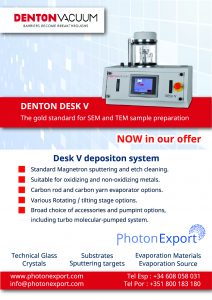Physical vapor deposition (PVD) is a process used to produce thin films or ‘coatings’ using a variety of methods involving vacuum deposits. First, a solid material is made into a vapor through a number of processes such as heating or sputtering.
Next, the vaporized substance is deposited on a receiving object, usually a substrate, as a coating of a thickness ranging from a few atoms (< 10 Å or 0,0001 µm) to 100 µm (the width of a human hair).
What are some industries Physical Vapor Deposition is used?
The PVD process is used in electronics, optics, and in chemical and mechanical use cases where a thin film is required, including:
- Semiconductor devices (e.g. thin-film solar panels)
- Specialist scientific instruments and tools
- Fabrication tools with PVD coating
- Food packaging (using aluminized PET film)
- Metalworking cutting tools (coated)
- Decorative coatings
|
What are Industrial and R&D applications of Physical Vapor Deposition?
Physical Vapor Deposition (PVD) has a range of industrial and research and development (R&D) applications, particularly in the field of sample preparation for microscopy and other research tools. One of the key applications is in preparing samples for Scanning Electron Microscopy (SEM) and Transmission Electron Microscopy (TEM), where a coating system is essential for enhancing the imaging and analysis capabilities of these microscopes.
SEM and TEM
PhotonExport supplies bench-top tools for SEM (Scanning Electron Microscopy) and TEM (Transmission Electron Microscopy) sample preparation or R&D applications where a coating system is needed for use on microscopes and other research tools. We offer the following carefully designed bench-top coating systems, all of which are compact and cost-effective solutions for in-house manufacturing.
Magnetron Sputtering
Magnetron sputtering is a vacuum-based coating process capable of depositing a wide range of materials, such as metals and ceramics, onto various substrates. This technique utilizes a unique magnetic field applied to a diode sputtering target, enabling high-rate coating applications.
Ion beam Milling
Ion Beam Milling involves directing a beam of ions onto a substrate within a vacuum chamber. This process relies on the transfer of momentum between the incoming ions and the atoms of the target material during their collision.
PVD Cluster
The machines designed for this method cater to both research and development as well as batch production, and can be readily customized to accommodate the size, shape, and specific requirements of the substrate.
Diameter to 300 mm PVD
This stainless steel compact coating system offers a complete range of vacuum systems, chamber and modular process accessories.
Designed to the stringent specifications of researchers and electron microscopists, this bench-top coating system is the perfect addition to any laboratory or research studio needing coating solutions for objects with substrate diameters of up to 300 mm in size.
Lab Coater-Diameter to 500 mm
- This bench-top coating system accommodates large diameter substrates up to 500 mm with a front-loading box chamber.
- Available processes include resistance evaporation, electron beam and sputter vaporization methods.
- Accommodates substrate holders with domes (simple or planetary motion) or functional single wafer substrates. Perfect for research and development or pre-production labs and studios.
Other Deposition Systems
Additional systems, offer greater processing capacity, glove box integration and box coaters with ion beam capability. Custom configuration options include a variety of chamber sizes, accessories, techniques and processes for the deposition step, and a choice of work holders, load locks and pumping options. PhotonExport can help you source the right array of features for your specialist needs.
Industrial Metallization Equipment
There are a number of options to select from when it comes to choosing the right industrial metallization equipment. Features include a choice of simple or double rotation movement for the system throughput, glow discharge with pre-cleaning, and chamber sizes of 1,700, 1,900 or 2,800 mm in diameter.

